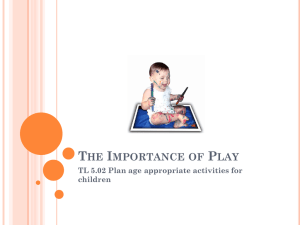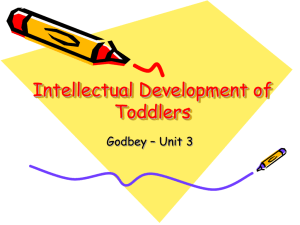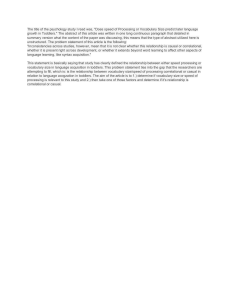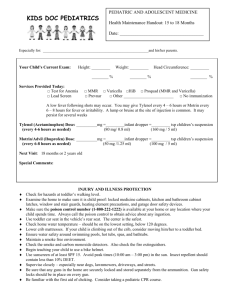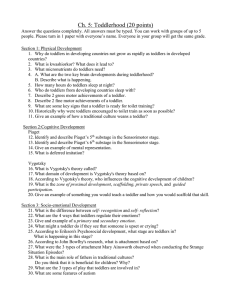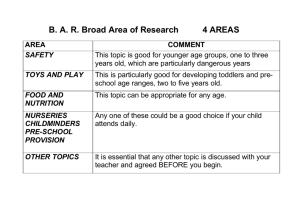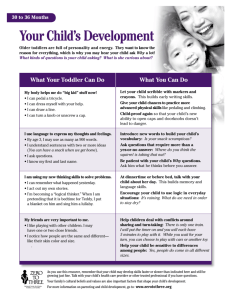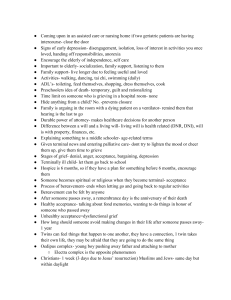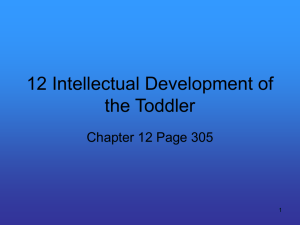Toddler Social/Emotional Development General Emotional Patterns
advertisement
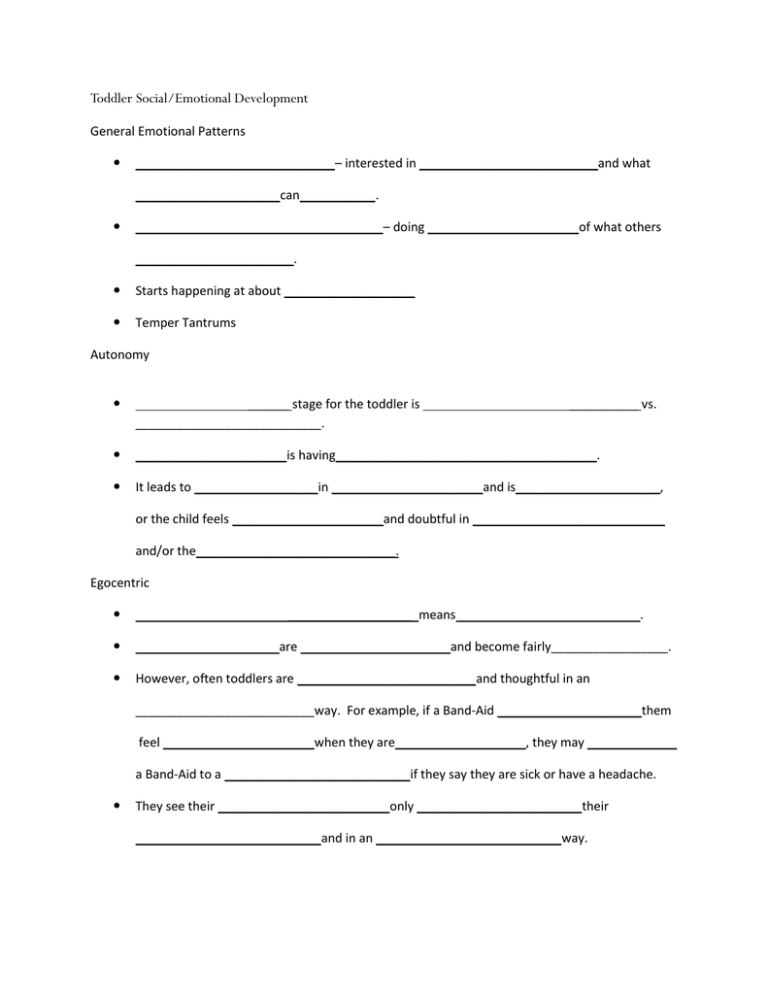
Toddler Social/Emotional Development General Emotional Patterns _____________________________– interested in __________________________and what _____________________can___________. ____________________________________– doing ______________________of what others _______________________. Starts happening at about ___________________ Temper Tantrums Autonomy ______ stage for the toddler is ___________________________. ______________________is having______________________________________. It leads to __________________in ______________________and is_____________________, __________ vs. or the child feels ______________________and doubtful in ____________________________ and/or the_____________________________. Egocentric __________________ means are . and become fairly_________________. However, often toddlers are __________________________and thoughtful in an __________________________way. For example, if a Band-Aid _____________________them feel ______________________when they are___________________, they may _____________ a Band-Aid to a ___________________________if they say they are sick or have a headache. They see their _________________________only ________________________their ___________________________and in an ___________________________way. Socialization A ________________________can encourage ________________________________in toddlers in many ways: -An _______________________________ way is by_________________________ social interaction with other_________________________. -The parents should ________________the child with a _________________adult ____________ in a_________________________. -Allow the __________________to_____________________ with other____________________. Making Friends The ability to make _________________is_________________to_________________________ social development. Even very young _________________need__________________with _______________people. This is how they the ______________________________of socialization. who have only companions may have _____________________interacting with All sometimes have Children need to how to their own age. and arguments. their problems. Patterns of Play There are ______ basic classifications of _______________________________________used by children. They are: 1. ______________________________BEHAVIOR: The ____________________ is __________ ____________________________ in any particular activity. He/she just ____________________________what seems interesting at the time. The child often appears to be day dreaming. 2. _______________________BEHAVIOR: This behavior involves _______________ other children_____________________. The child may________________________ to the __________________________ who are _________________________but does____________ become actively___________________________. (TODDLERS) 3. __________________________PLAY: This type of play____________________ a child playing__________________________. He/she has_________interest in _____________________else or that they______________________. (INFANTS) 4. _____________________PLAY: This type of play _________________________a child playing beside other__________________________. There is________actual_____________________. (2-3 YEARS) 5. ____________________________PLAY: This type of play______________________ a child ______________________with _______________________children. The children____________ toys and _________________________________with one another. Each child does what he/she ______________________but is a ___________________of a large ________________ (3 YEAR – SCHOOL AGE) 6. ______________________________PLAY: This type of play involves____________________. There are usually ____________________________and ___________________________ in this type of play. Types of Play _________________________is an_________________________ part of a child____________. It provides purpose for the child. Children must___________________ to _____________them ______________________. There are ___________ basics _________________of ________________________: 1. ____________________________l- Play develops _____________________and _____________ muscles and increases speed, ______________________________and coordination. 2. __________________________-Children learn how to ___________________________their ___________________________ and ______________________through play. 3. _____________________________-Play ____________________them how things ____________________. 4. ____________________________________-Play _________________________________them the type of social behavior that is____________________________. 5. ______________________-Children learn to be ______________________and______________ as they play. Types of play There are many types of play. Some general types are listed below: Dramatic or ____________________________Play The child is involved in make-believe or ________________________situations. During dramatic play, children may ____________________things they have _______________________such as happy moments, sad moments, fears or anxieties. A child is ___________________________ in playing and___________________ Active Play with ______________________and/or with objects. Passive Play with anyone Skill Mastery Play A child does ______________ or______________________________________. This type of ____________________occurs when child_____________________ or is ______________________to learn a new_________________. Sensory Motor Play This type of play occurs when a child __________________________or is ___________________________________ to learn a ______________skill. Rough and Tumble Play This type of play can________________________ a great deal like___________ or fighting. Social/Emotional Of Toddlers Playing ___________________________helps build- Emotional and social skills _______________________is a child’s ____________________- it is the way they ______________________things Emotions __________________usually _____________________their _________________spontaneously and often show a ________________________of emotions in just a few___________________. Toddlers ________________to ____________________others’ _____________________and usually ________________________them. If a ___________________________acts_______________, the ______________________is most likely to act _______________________as well. Toddlers have a ___________________time _______________________fact from ___________ and may __________________a great deal of __________________at _____________ and _______________________objects and people. Security Objects It is important in ____________________a child learn to ______________________her/himself. A _____________________________becomes _____________________at bedtime. Imaginary Friends __________________are usually _________________to a ____________or ____________child. Most _____________________olds have _____________________________friends. These are ____________________of a developing____________________________. They _________________a child a _____________________way to ____________________out who he/she _____________________to be. It is also a __________________for a child to __________________with people who are __________________________________to him/her. They are a _____________of healthy ______________________and ______________________ development. It is also a ____________for them to __________________out what their __________________ will ____________________by having their “__________________” try things out for them. The value of an imaginary friend is that it ________________________a child’s _____________ and helps him/her _____________out __________________________problem.


